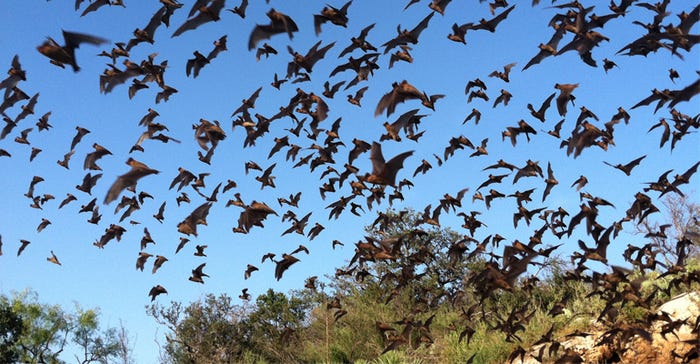
Oct. 24 through Oct31, is Bat Week as declared by Agricultural Secretary Sonny Purdue. While it has very little to do with Halloween, Bat Week is a growing celebration observed in both the U.S. and across the world focusing on the benefits the winged creatures provide, especially to agriculture.
“Bats are amazing creatures vital to the health of our natural world and economy,” states Ann Froschauer, U.S. Fish and Wildlife Service, Pacific Region White-nose Syndrome coordinator. “Although we may not always see them, bats are hard at work all around the world each night.”
Bats eat insects such as mosquitoes and are credited with providing an estimated $53 billion in nontoxic pest control around the world each year. Bats also help pollinate plants and distribute seeds in tropical and subtropical habitats, according to the Center for Biological Diversity website.

Research in recent years has shed light on the role bats play and concerns about the diminishing bat population, worldwide.
In Secretary Perdue’s latest Bat Week Proclamation, he expresses concern over decreasing bat population numbers.
“Recent bat population losses from White-nose syndrome and other factors require attention to ensure the sustainability of our food production systems, avoid additional economic impact on the agricultural sector, and protect environmental health,” Secretary Perdue notes in the proclamation.
The U.S. Forest Service conducted research into the importance of healthy bats populations in recent years. Last year, the Forest Service’s Rob Harper, national director for the Water, Fish, Wildlife, Air, and Rare Plants, said bats provide incredibly valuable ecosystem services to society’s well-being.
“Many agricultural crops and native plants depend wholly or partially on bats to pollinate their flowers or spread seeds. Bats also help control damaging or bothersome insect pests. Addressing the decline of bats across North America is one of the most important conservation efforts that private sector partners, the states, tribes, and federal agencies can agree to and work together on,” he said.

Secretary Perdue’s Bat Week proclamation outlines some of the dangers and steps the USDA is taking to address problems associated with bat conservation.
“The U.S. Department of Agriculture is providing a national response to the spread of white-nose syndrome by co-leading an interagency and international team focusing on bat research, inventory, and monitoring as part of a science-based strategy to reduce the disease's impact on bat populations.
“It is critically important to continue federal efforts, including developing new public-private partnerships and increasing citizen engagement, to promote the health of bat populations, increase the quality and quantity of bat roosting and foraging habitat, and help restore bat populations to healthy levels.”
Bat Facts, according to batweek.org
Bats come in all shapes and sizes, from the tiny, adorable bumblebee bat that weighs less than a penny to the big, beautiful flying foxes that can have a wingspan of up to six feet.
Bats are the only mammal that can truly fly (although some other mammals “glide”). A bat’s wing is actually a modified hand—similar to yours.
Contrary to popular belief, bats actually have good eyesight (similar to that of humans), but for most species, their main technique for navigating or locating prey is using echolocation (not all species echolocate!): emitting very high- pitched sounds that bounce off obstacles in their path, like trees, other bats, buildings, and food. main target—delicious insects. Not all bats that echolocate are insectivores!
Bats eat lots of different things. Although almost 70 percent of bat species feed primarily on insects, some bats are carnivorous, eating meat like rodents, frogs, and fish. Only three species of bats feed on animal blood, with two of these species specializing on bird blood. Many other bats eat pollen, nectar or fruit—these bats are vital for pollinating flowers and spreading seeds that grow new plants and trees.
For more information or for resources about Bat Week, visit http://batweek.org.

About the Author(s)
You May Also Like






